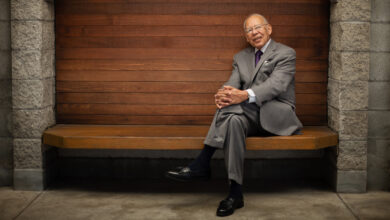Gender Difference Is Real, but Too Complex to Spell Out All the Specifics

When asked to define time, Augustine remarked that he knew what it was until someone asked him to define it. One could say the same of the term gender in contemporary debate. Although there is no lack of debate about gender, rarely is the term clearly defined.
In his book Gender as Love: A Theological Account of Human Identity, Embodied Desire, and Our Social Worlds, theologian Fellipe do Vale aims to bring greater clarity to the concept of gender. In doing so, he refuses the binary framing that casts it as a matter of either pure biology or pure social construction. Instead, he draws on an Augustinian theology of love to argue that gender refers to a “bundle” of human loves and social goods that shape how we manifest our male and female bodies.
Further, do Vale clarifies that affirming the basic reality of gender does not entail affirming an exhaustive and fully cohesive understanding of it, in part because our knowledge is shaped by our narrative context. That is, our place in the story of creation, fall, redemption, and consummation affects both the lived reality of gender and our capacity to know the fullness of what it signifies.
Between the essentialists and the constructivists
Do Vale’s critique and constructive proposal unfolds in three sections. In the first, he draws on the late theologian John Webster, arguing for a “theologically theological anthropology” that comprehends gender within biblical and theological sources rather than merely building on or reacting to the existing claims of philosophy and sociology. Having laid this foundation, he engages the dominant view of gender today—namely, that we construct it according to personal desires and social conventions rather than inheriting it as a fixed reality rooted in biology.
As do Vale argues, this “constructivist” argument fails for two reasons. First, this position ends up dissolving any meaningful reference to men or women as such. If the meaning of woman and man varies from culture to culture, then we lose any ability to speak or act (politically or ethically) with reference to these categories. Second, if this position is correct, we cannot meaningfully evaluate any particular cultural practice related to gender. Without some kind of ontological anchor, judgments of better or worse, just or unjust, lack any solid footing. The gender-skeptical position of the constructivists thus leads to problematic ethical conclusions.
In the second section, do Vale presents his constructive proposal on gender. Against the constructivists, he argues that gender is an essence, though not merely of a biological nature. He contends that, taken together, the complexity of gender, the effects of the Fall on sinful minds, and the ethical effects of injustice preclude anyone from enjoying full and direct access to the essence of gender. Given the effects of sin, he argues, any theology of gender must cultivate justice in the here and now, as we await a perfected understanding of gender in the world to come.
Drawing on Augustine, do Vale presents a theology of human love in which “human identity is a bundle of many loves, and included in that bundle are the complex social identities that we bear, like gender.” This lays the groundwork for his central claim that gender is love—or, more specifically, to invoke his technical language, that gender is the love of certain goods, including social goods, by which the sexed body is socially manifested.
This complex reality is neither merely biological (per some essentialists) nor strictly cultural (per constructivists). Rather, gender is one way inherently cultural beings make sense of the givenness of the world, including the maleness and femaleness of bodies.
In the book’s third and final section, do Vale delves further into the complex relationship between gender and the biblical storyline. In the context of creation, he acknowledges the pain and suffering of intersex individuals and others born with sexual irregularities. But he cautions against the theological moves made by thinkers like Susannah Cornwall and Megan DeFranza who, he contends, suggest a kind of Gnostic redemption from the categories of creation, not from sin and its effects.
In his section on the Fall, do Vale explores sexual assault as a signal instance of warped gender expression, noting that it warps the oppressor even as it transgresses the dignity and value of the victim. Finally, he articulates a vision of redemption and consummation that, rather than erasing who we are as male and female, restructures our disordered loves and purges false distinctions of superiority and inferiority attached to gender. Seen in this light, the church’s central task is not to present an exhaustive theory of gender but to model patience and grace as we await the consummation of all things, gender included.
Clarity and confusion
Gender as Lovehas a number of strengths. Do Vale rightly resists the simplistic binary of nature and culture that stands beneath the social constructionist view of gender. And he charitably but clearly points out the metaphysical and ethical deficiencies that prevent this view from speaking or acting coherently.
Furthermore, do Vale helpfully distinguishes between ontology and epistemology, clarifying that both reality and our knowledge of it are affected by our position within the biblical story. This gives us confidence in the enduring, transcultural reality of gender while encouraging humility in our efforts to define and understand it within particular cultures.
Yet do Vale’s work, while helpful in some respects, does have shortfalls. On the one hand, I appreciate his emphasis on a kind of pragmatic realism about gender norms. He is correct, I believe, that the church’s most pressing need is not to identify some timeless set of gender norms but rather to engage discerningly with the gender expressions that exist within our particular cultures.
All cultures have identified certain social goods in gendered ways, some of which are more defensible than others. Our first task is to describe these social goods accurately, determining what they mean for the culture in question—and how they are gendered (as in Paul’s reference to women wearing veils in 1 Corinthians 11). Without first laying this descriptive foundation, we cannot engage in any kind of moral or theological reflection. Within each cultural context, though, we must press on to ask: How should we, as Christian women and men in this culture, love these goods in relation to our male and female bodies?
And this is where I’m unsure whether do Vale’s proposal brings greater clarity to the confusions around gender today. He does affirm the biological distinctions between men and women, and he is insightful in describing how individuals come to a sense of gender identity. But even here some ambiguity creeps in.
Do Vale agrees, at the outset of the book, that the differences between male and female are differences in kind rather than degree, in that there are certain properties that define one as male or female exclusively. Later on, however, he is unwilling to specify any of these properties, which seems to imply that gender is something that transcends them. If we can’t state any definitive properties of being male or female, how can we hope to even approximate them this side of heaven?
How does one make prescriptive judgments about being properly masculine or feminine? Do Vale speaks of rightly ordered gendered goods as being used for the flourishing of humanity. And he speaks of disordered gendered loves as being unjust, harmful, and oriented toward dominating others. But this definition supplies no concrete criteria for determining what is just or unjust, or what counts as flourishing rather than harm. In today’s cultural context, justice language (“oppression,” “harm,” “unjust”) can rival gender language in its occasional lack of conceptual clarity. Thus, do Vale’s combination of gender and justice language raises as many questions as it answers.
In a similar vein, it’s unclear how do Vale’s ideas can help us sort through complex questions of transgender identities or gender roles. For example, does an individual’s love of certain gendered goods entail belonging to that gender? If, for instance, a man (a person with a male sexed body) loves the goods associated with femininity in contemporary American culture, is that person’s gender identity female even though his sexed body is male? From a purely descriptive angle, do Vale’s answer would appear to be yes.
To be clear, I am not at all sure do Vale actually wants to draw this conclusion. I recognize that his book is a highly technical treatment of gender and theology, but its value could have been enhanced by more clearly spelling out the practical implications and judgments entailed in certain contested areas.
On the whole, though, do Vale’s work is a helpful and engaging resource for those who want to take a deep dive into contemporary gender theory and theological engagement with it. He should be commended for affirming a clear theological grounding for gender, offering a helpful Augustinian framework for relating gender to human loves, and reminding us to view passing gender controversies—important as they are—in the light of God’s ongoing work of redemption.
Branson Parler is director of theological education and professor of theology at The Foundry. He is the author of Every Body’s Story: 6 Myths About Sex and the Gospel Truth About Marriage and Singleness.




